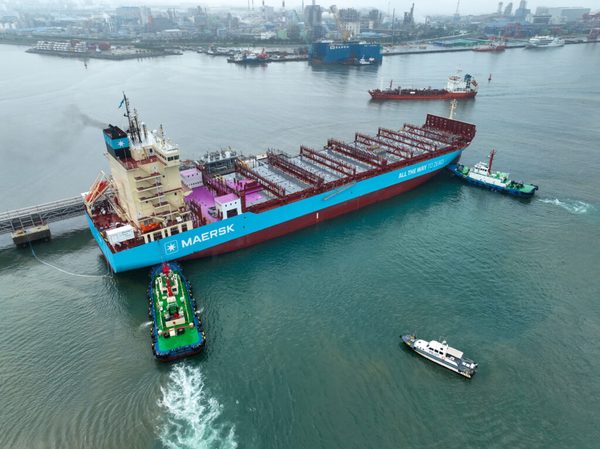The Week in Alternative Fuels
This week's top headlines highlight opportunities and barriers to using low- and zero-emission marine fuels on ships.
 PHOTO: Maersk's 2,100 TEU feeder vessel being bunkered with methanol supplied by OCI HyFuels in Ulsan, South Korea. Ulsan Port Authority
PHOTO: Maersk's 2,100 TEU feeder vessel being bunkered with methanol supplied by OCI HyFuels in Ulsan, South Korea. Ulsan Port Authority
Transport & Environment (T&E) research deemed the current version of FuelEU Maritime to "not [be] ambitious enough" to reduce EU dependence on fossil fuels by 2050. A T&E study found that green e-fuels need to account for 18% and 85% of fuel consumed onboard vessels by 2035 and 2040, respectively, to keep shipping on track to do its part to meet the Paris Agreement.
That compares to several times lower FuelEU Maritime targets of 6% by 2035 and 24% by 2040.
But to meet the e-fuels uptake targets proposed in FuelEU Maritime, or in T&E's higher estimate for what's needed, the shipping industry needs greater access to e-fuels. Uncertainty around future green e-fuels availability has held many shipowners back from investing in zero-emission capable ships. However, there has been some momentum building in supply-side developments recently, and also this week. An unnamed Chinese energy company announced plans to build a 10,000 mt/year e-methanol plant by June next year to meet growing bunker demand from the shipping sector.
Methanol made several headlines this week. OCI HyFuels said it had carried out Ulsan’s first ever biomethanol bunker delivery. It was Maersk’s widely promoted feeder vessel that was bunkered in the South Korean port. The 2,100 TEU feeder is equipped with a low-speed dual-fuel engine made by MAN Energy Solutions (MAN ES), which has also been working with Maersk to install dual-fuel engines on the much larger 16,000-17,000 TEU container ships it has on order.
MAN ES separately announced it is spearheading a research project to convert its medium-speed four-stroke marine engines to be able to run on methanol.
In ammonia, Japanese engineering firm IHI Corporation is exploring whether green ammonia can be produced in New Zealand's Greenpoint and Tiwai Point, and exported to overseas markets. A proposed plant is projected to have capacity to produce 500,000 mt/year of ammonia using hydropower as its source of electricity.
Lloyd's Register (LR), however, provided a realistic perspective on green fuel supply for shipping. While LR views methanol as a viable energy option with zero-emission potential, it warned that high costs and limited availability of synthetic e-methanol and bio-methanol could inhibit widespread adoption over the coming decades.
In such a situation, ammonia could serve as an alternative to methanol since it offers zero-emission potential. DNV projects that prices for both blue and green ammonia will be lower than for bio- and e-methanol by 2050. According to classification society, green ammonia prices are projected to be $15-31/GJ in 2050, which is significantly lower than $25-45/GJ for e-methanol.
But ammonia’s use as a marine fuel has been held back by lacking technological readiness so far, as ship engines will have to be completely redesigned if they are to run on pure ammonia.
Nevertheless, recent updates suggest that ammonia could be used onboard vessels as early as 2024, when MAN ES aims to release its first two-stroke dual-fuel ammonia engine. A pledge by Swiss engine maker Winterthur Gas & Diesel (WinGD) to deliver a dual-fuel ammonia engine in 2025 could further accelerate its use on ships.
By Konica Bhatt
Here is our selection of top five alternative fuels stories from this week:
FuelEU Maritime ‘not ambitious enough’ – T&E
Chinese firm to build e-methanol plant to meet shipping demand
Japanese firm explore ammonia production and export in New Zealand
Pricing, availability among shipping's top obstacles for methanol uptake – LR





